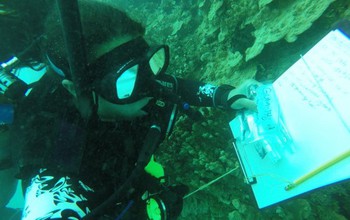All Images
News Release 17-043
Bacteria living in marine sponge produce toxic compounds found in man-made products
Finding puts researchers closer to understanding human health implications of additives that make materials flame retardant
This material is available primarily for archival purposes. Telephone numbers or other contact information may be out of date; please see current contact information at media contacts.

Scripps Institution of Oceanography scientists study marine sponges in the waters off Guam.
Credit: Jason Biggs
Download the high-resolution JPG version of the image. (80.8 KB)
Use your mouse to right-click (Mac users may need to Ctrl-click) the link above and choose the option that will save the file or target to your computer.

Researchers at the University of Guam sample sponges at a place called Piti Bomb Holes off Guam's coast.
Credit: Jason Biggs
Download the high-resolution JPG version of the image. (114.5 KB)
Use your mouse to right-click (Mac users may need to Ctrl-click) the link above and choose the option that will save the file or target to your computer.

Researchers collect marine specimens such as this sponge and bring them back to the lab for study.
Credit: Jason Biggs
Download the high-resolution JPG version of the image. (57.4 KB)
Use your mouse to right-click (Mac users may need to Ctrl-click) the link above and choose the option that will save the file or target to your computer.

Bacteria inside sponges and other marine animals produce toxic substances.
Credit: Jason Biggs
Download the high-resolution JPG version of the image. (121.3 KB)
Use your mouse to right-click (Mac users may need to Ctrl-click) the link above and choose the option that will save the file or target to your computer.

Scripps Institution of Oceanography researchers Brad Moore (left) and Vinayak Agarwal in the lab.
Credit: Yuta Kudo
Download the high-resolution JPG version of the image. (70.9 KB)
Use your mouse to right-click (Mac users may need to Ctrl-click) the link above and choose the option that will save the file or target to your computer.

Vinayak Agarwal of the Scripps Institution of Oceanography looks at bacteria in marine sponges.
Credit: Jason Biggs
Download the high-resolution JPG version of the image. (55.7 KB)
Use your mouse to right-click (Mac users may need to Ctrl-click) the link above and choose the option that will save the file or target to your computer.
